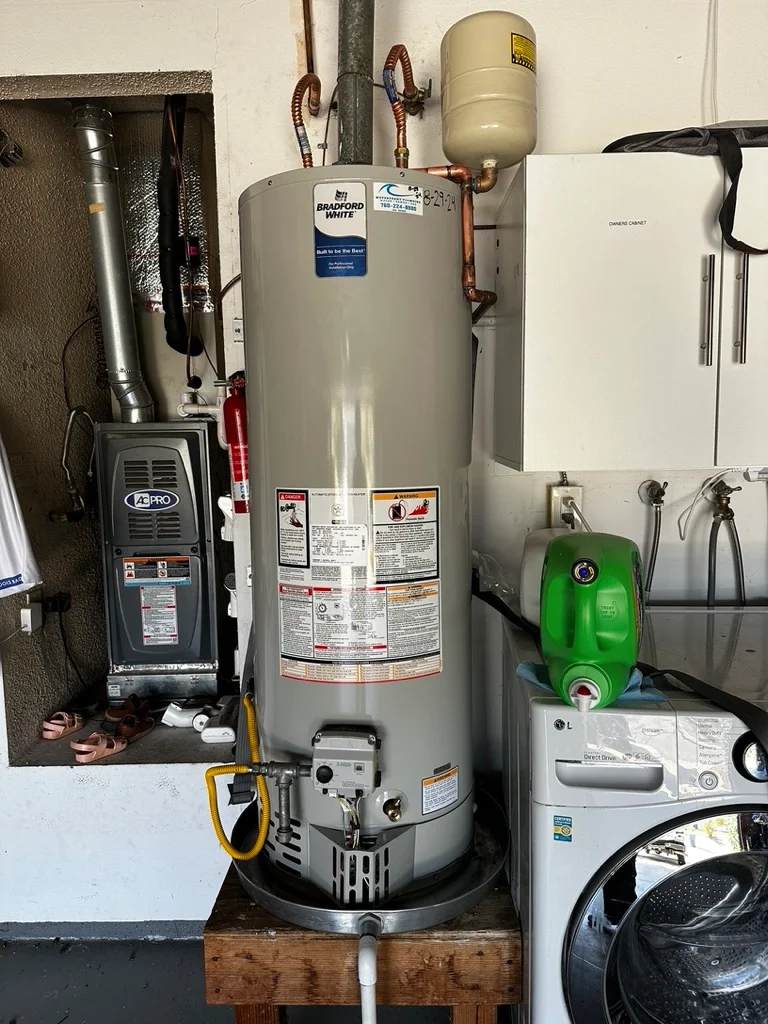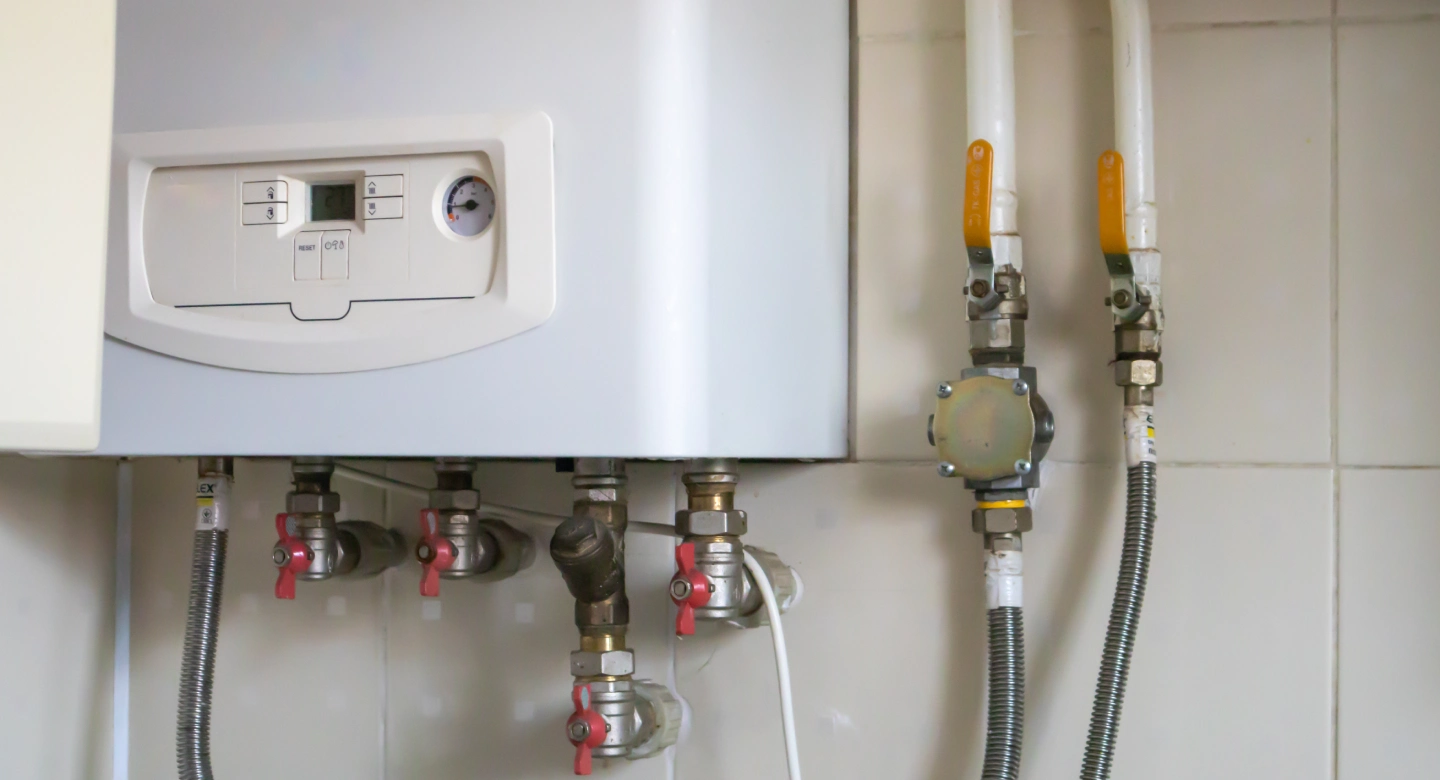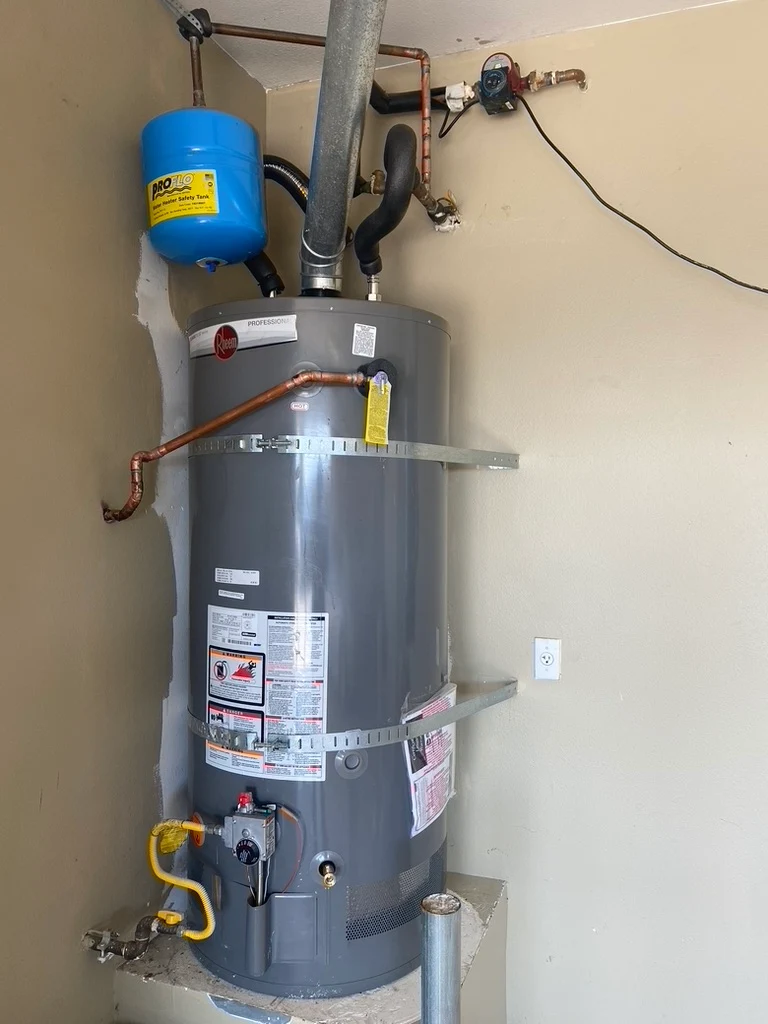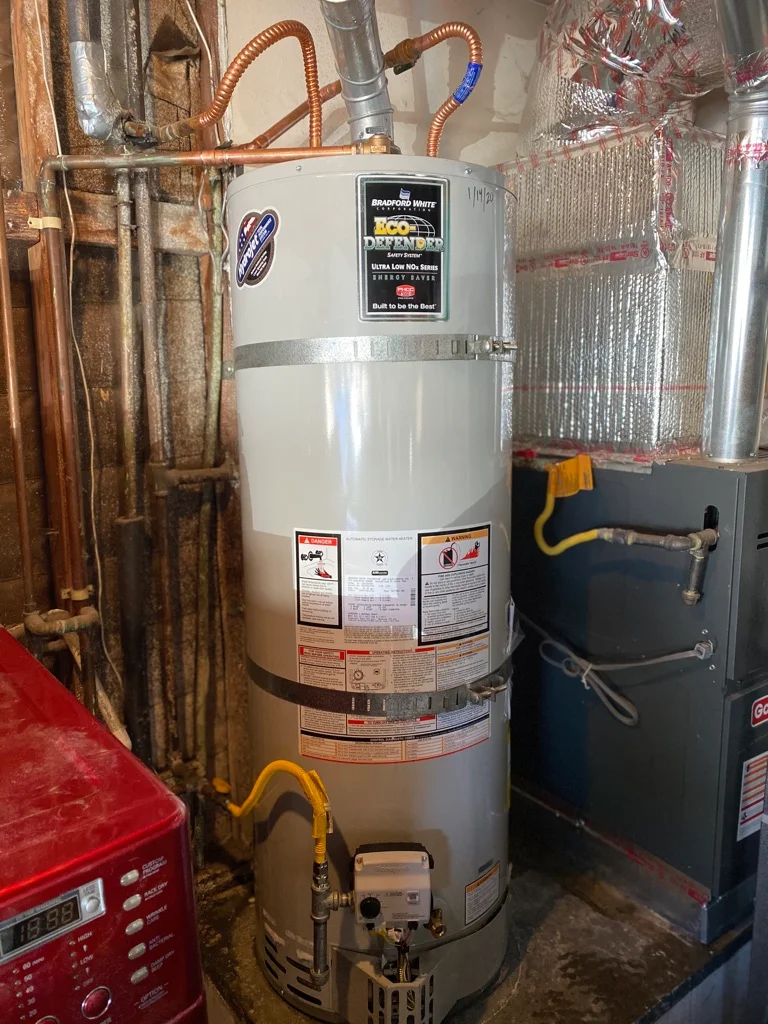Regular water heater maintenance is one of the most essential—and often overlooked—responsibilities for homeowners. Whether you own a conventional tank-style unit or a modern tankless system, keeping your water heater in peak condition can help you avoid unexpected breakdowns, reduce energy costs, and extend the life of your system.
When performed regularly, maintenance tasks like flushing sediment, checking pressure relief valves, and inspecting for corrosion can significantly improve both performance and safety. A clean, well-maintained unit delivers more consistent hot water, enhances efficiency, and reduces the risk of costly repairs down the line.
If you prefer to leave the work to experienced professionals, Waterfront Plumbing is here to help. This local, family-owned company brings over 25 years of hands-on experience in water, sewage, and gas systems. Known for their honesty, integrity, and commitment to quality, they focus on doing the job right the first time—efficiently and thoroughly. Whether you’re dealing with a gas, electric, or tankless water heater, they offer same-day emergency service for 20–30% of calls and are available 24/7 to respond when you need them most.
This guide will walk you through everything you need to know about maintaining your water heater—whether you plan to do it yourself or work with a trusted team like Waterfront Plumbing, who puts your comfort and safety first.
Understanding Your Water Heater
Before diving into maintenance tips, it’s essential to understand the type of water heater you have, the components that make it work, and how the system functions. This basic knowledge helps you make informed decisions and recognize early signs of potential issues.
Types of Water Heaters
Water heaters come in a few main types, and knowing what kind you own will determine your maintenance routine:
- Tank Water Heaters: These are the most common in residential homes. They store a specific amount of hot water (typically 30–80 gallons) in a tank and keep it heated around the clock.
- Tankless Water Heaters: Also called on-demand systems, tankless heaters heat water only when you turn on a hot water tap. They are energy-efficient and take up less space, but may require more frequent descaling in areas with hard water.
- Gas Water Heaters: These use natural gas or propane to heat the water. They generally heat faster than electric models and can continue working during power outages.
- Electric Water Heaters: Powered by electricity, these are often easier to install and maintain, but they may have slower heating times and higher energy costs depending on your utility rates.
Basic Components
Whether you have a tank or tankless model, all water heaters share key components that play crucial roles in heating and delivering hot water:
- Tank (in tank systems): Stores and maintains hot water until needed.
- Thermostat: Controls the water temperature and signals the heating element or burner to activate.
- Heating Elements: Electric units use one or two heating elements inside the tank; gas units use a burner at the bottom.
- Anode Rod: A sacrificial metal rod that attracts corrosion, protecting the tank’s inner lining.
- Pressure Relief Valve (TPR Valve): A critical safety feature that releases water if internal pressure or temperature becomes too high.
Understanding these components helps identify where issues may originate during maintenance checks.
How It Works
While designs vary slightly between models, all water heaters follow a similar process to deliver hot water:
- Heating Process: Cold water enters the system through an inlet pipe. In gas models, a burner heats the water at the bottom of the tank. In electric models, one or two heating elements warm the water directly. Tankless systems use a heat exchanger to instantly heat water as it flows through.
- Water Storage or On-Demand Flow:
- Tank models maintain a reservoir of hot water that’s ready for use at all times.
- Tankless models skip the storage process and deliver hot water on demand, which reduces standby energy loss.
By knowing how your system works, you’ll be better equipped to spot early signs of trouble, perform routine maintenance, and recognize when it’s time to call a professional. For homeowners who prefer expert help, trusted local providers like Waterfront Plumbing can step in to ensure your system runs safely and efficiently.
Understanding Your Water Heater
Getting familiar with how your water heater works is the first step in maintaining it properly. Whether you have a traditional tank model or a newer tankless system, understanding the type, parts, and basic operation of your unit can help you troubleshoot issues and take preventive steps to extend its lifespan.
Types of Water Heaters
There are two main distinctions when it comes to water heaters: how they store and heat water, and what energy source they use.
- Tank vs. Tankless Systems:
- Tank water heaters store a set amount of hot water—usually between 30 to 80 gallons—and keep it heated until it’s used. These are common in older homes and are known for having lower upfront costs but higher standby energy loss.
- Tankless water heaters, also known as on-demand heaters, don’t store hot water. Instead, they heat water instantly as it passes through the unit. These models save energy and space but may cost more upfront and require more frequent descaling in hard water areas.
- Gas vs. Electric Models:
- Gas water heaters use natural gas or propane as their heat source. They heat water quickly and remain functional during power outages, but they need proper ventilation and regular gas line inspections.
- Electric water heaters are powered by electricity and are easier to install and maintain. They tend to be more energy-efficient in well-insulated models but can take longer to heat water and may cost more to run depending on local electricity rates.
Basic Components
Every water heater, whether tank or tankless, consists of several essential parts that keep it functioning safely and efficiently:
- Tank (in tank systems): Stores hot water and is typically lined with glass or ceramic to resist corrosion.
- Thermostat: Regulates the water temperature and signals the system to begin heating when the temperature drops below the set level.
- Heating Elements or Burners:
- Electric models use heating elements immersed in the water.
- Gas models have a burner at the base of the tank that heats the water from below.
- Anode Rod: A metal rod (usually aluminum or magnesium) inserted into the tank to attract corrosive minerals and prevent rust from damaging the tank lining.
- Pressure Relief Valve (TPR Valve): A vital safety component that opens to release water and lower pressure if the tank becomes too hot or pressurized.
Knowing these parts helps you perform basic checks and understand what a professional might inspect or replace during service.
How It Works
Water heaters follow a straightforward process, whether they are storage or on-demand models.
- Heating Process:
- Cold water enters the unit through a dip tube or inlet pipe.
- In gas heaters, a burner ignites at the bottom of the tank, heating the water above.
- In electric heaters, heating elements warm the water directly.
- Tankless models use a heat exchanger that activates when water flows through, rapidly heating it without storing it.
- Water Storage or On-Demand Flow:
- In tank systems, hot water is stored and held at a constant temperature until it’s used. When you turn on a faucet, the water flows from the tank to the tap, and cold water refills the tank to begin reheating.
- In tankless systems, water is heated only when you need it. This eliminates standby heat loss and provides unlimited hot water, though it may take a second or two to reach the tap.
Understanding these basics will help you better care for your water heater and recognize when something isn’t working as it should.
Why Water Heater Maintenance Matters
Routine water heater maintenance is one of the most effective ways to protect your home investment. Neglecting your water heater can lead to unexpected breakdowns, higher utility costs, and even water damage, but a little preventive care goes a long way. Here’s why every homeowner should make water heater maintenance a priority:
- Prevents Costly Breakdowns:
Over time, sediment builds up inside the tank (especially in areas with hard water), which can cause your unit to overheat, make strange noises, or stop working entirely. Regular flushing, inspections, and part replacements can help you avoid emergency repairs or premature failure. - Improves Efficiency and Reduces Energy Bills:
A well-maintained water heater operates more efficiently. When heating elements are clean and sediment is removed, the system doesn’t have to work as hard to deliver hot water. This leads to lower energy consumption and noticeable savings on your monthly utility bill. - Extends the Lifespan of the Unit:
Most water heaters are designed to last 8 to 12 years, but with proper care, some units can perform well beyond that range. Tasks like checking the anode rod, flushing the tank, and inspecting the pressure relief valve can add years to the life of your system. - Enhances Water Quality and Safety:
Maintenance helps prevent rust, scale buildup, and bacterial growth inside your water heater, all of which can affect water clarity, smell, and taste. A clean system also reduces the risk of scalding or pressure-related malfunctions, improving safety for everyone in the home.
By investing just a little time into regular upkeep, you ensure consistent hot water, avoid costly repairs, and extend the life of your system. For anything beyond basic maintenance, trusted professionals like Waterfront Plumbing offer dependable, efficient service to keep your water heater performing at its best.
Water Heater Maintenance Checklist
Regular maintenance is essential for keeping your water heater running safely, efficiently, and reliably. Neglecting even small issues can lead to costly breakdowns, energy waste, or water damage. At Waterfront Plumbing, we offer expert maintenance services that cover every aspect of your system, so you don’t have to worry about the details. Here’s what a thorough water heater maintenance routine includes:
1. Check the Temperature Setting
Maintaining the correct temperature setting improves both safety and energy efficiency.
- Recommended setting: 120°F to prevent scalding and reduce energy costs.
- Adjustments should always be handled by a qualified technician, especially on older or gas-powered units.
2. Inspect for Leaks or Corrosion
Leaks and rust can indicate internal damage or aging components.
- Common problem areas include the base of the unit, valves, and pipe connections.
- Our team checks all fittings, seals, and joints to catch issues before they escalate.
3. Flush the Tank (Annually)
Sediment buildup can reduce efficiency and shorten the lifespan of your unit.
- Waterfront Plumbing performs full-system flushing to remove sediment and mineral deposits from both tank and tankless models.
- This service improves performance and helps prevent overheating or noise issues.
4. Test the Pressure Relief Valve
This valve is a critical safety feature that must function properly at all times.
- We test and inspect the valve to ensure it will release pressure safely if needed.
- If the valve shows signs of wear or leaking, we’ll recommend a prompt replacement.
5. Inspect and Replace the Anode Rod
The anode rod protects your tank from internal rust and corrosion.
- Over time, the rod deteriorates and needs replacement to continue protecting the tank lining.
- Waterfront Plumbing technicians check the condition of the rod during annual inspections and replace it when needed.
6. Check for Signs of Wear or Rust
Visual signs of wear often reveal deeper issues.
- We examine the entire unit—including exterior surfaces, burner compartments, and fittings—for rust, discoloration, or unusual wear patterns.
- These inspections help catch issues early before they become emergencies.
7. Clean the Inlet Filter (Tankless Units)
Clogged inlet filters reduce water pressure and heating performance.
- For tankless systems, we remove and clean the inlet filter to ensure proper water flow.
- Regular cleaning helps prevent costly damage to heat exchangers and internal components.
8. Schedule an Annual Professional Inspection
A yearly inspection is one of the most effective ways to keep your water heater operating smoothly.
- Waterfront Plumbing’s expert team performs comprehensive system checks, from thermostats and heating elements to gas line connections and venting systems.
- With 24/7 availability and same-day emergency service for many calls, we’re ready to respond when it matters most.
Keeping your water heater in top condition doesn’t have to be complicated. Trust Waterfront Plumbing to handle the full maintenance process with integrity, efficiency, and the experience that comes from more than 25 years in the field.
Common Water Heater Issues and How to Spot Them
Even with regular maintenance, water heaters can still develop issues over time. Identifying these problems early can help prevent more serious damage and costly repairs. Below are some of the most common water heater issues homeowners face—and the warning signs to watch for.
No Hot Water or Not Enough
One of the most obvious signs of trouble is when your water heater stops delivering hot water or produces less than usual.
- Possible causes:
- A tripped circuit breaker (electric units)
- A failed heating element or gas burner
- A malfunctioning thermostat
What to check: Ensure the power or gas supply is active and inspect the thermostat setting. If those are working, you may need to replace a component or call a professional.
Water Takes Too Long to Heat
If it feels like you’re waiting forever for hot water, it could be more than just a minor annoyance.
- Possible causes:
- Sediment buildup in the tank reduces heating efficiency
- A failing heating element or burner
- Incorrect thermostat settings
Solution: Try flushing the tank to remove sediment and check the thermostat. If the issue continues, it may be time for repairs or a system upgrade, especially if your unit is aging.
Discolored or Smelly Water
Rusty or foul-smelling water from hot taps can be a sign of internal corrosion or bacterial growth.
- Possible causes:
- Rust inside the tank or a corroded anode rod
- Bacteria reacting with sediment or the anode rod (especially in well water systems)
- What to look for:
- Brown, yellow, or reddish water from hot taps
- Rotten egg or sulfur-like odor
Solution: Replacing the anode rod or flushing the system with hydrogen peroxide can help. Persistent issues may require tank replacement.
Strange Noises (Popping, Rumbling)
Unusual sounds coming from your water heater typically point to sediment buildup inside the tank.
- What causes it: As water heats up, sediment hardens and causes mini-explosions or popping sounds as bubbles push through the debris.
What to do: Flushing the tank can often solve this issue. If noises persist after a flush, it could mean the sediment has solidified or the tank is nearing the end of its life.
Leaks or Moisture Around the Unit
Water pooling around your heater is never a good sign and should be addressed right away.
- Common sources:
- Loose or corroded fittings
- A faulty temperature and pressure relief valve
- Cracks in the tank (usually irreversible)
- What to do: Check all connections and valves. If the leak is coming from the tank itself, replacement is typically the only solution.
Staying alert to these issues and addressing them promptly can save you time, money, and inconvenience. Regular maintenance reduces the likelihood of many of these problems, but when in doubt, don’t hesitate to bring in a licensed plumber or technician.
When to Repair vs. When to Replace
Knowing when to repair your water heater versus when to replace it can save you money and help avoid unexpected breakdowns. While many issues can be resolved with simple fixes, there comes a point when replacement becomes the more practical and cost-effective option.
Average Lifespan of Different Water Heater Types
Understanding how long water heaters typically last helps set realistic expectations.
- Tank water heaters (gas or electric): 8–12 years
- Tankless water heaters: 15–20 years with proper maintenance
If your unit is approaching or past its expected lifespan and showing signs of wear, replacement is often the smarter long-term investment.
Signs It’s Time for a New Unit
Some issues can be repaired, but others suggest your water heater is on its last leg.
- Frequent or recurring repairs (especially on older units)
- Rusty water or visible rust on the tank
- Leaks coming from the tank itself
- Increasing energy bills despite routine maintenance
- Inconsistent water temperature or prolonged heat-up times
- Strange noises that persist after flushing
These warning signs often indicate internal damage or failing components that are costly or impossible to fix.
Cost Comparison of Repair vs. Replacement
Weighing the cost of repair against replacement can guide your decision.
- Typical repair costs:
- Thermostat replacement: $100–$300
- Heating element or burner repair: $150–$400
- Anode rod replacement: $100–$250
- Typical replacement costs:
- Tank water heater: $800–$2,000 (including installation)
- Tankless water heater: $1,500–$3,500 (higher upfront, lower long-term costs)
If a repair costs more than 50% of the price of a new unit—and the system is already more than 8–10 years old—replacement is generally the better option. Plus, modern water heaters are more energy-efficient and may offer rebates or tax credits, reducing the net cost of an upgrade.
Making the call to repair or replace doesn’t have to be complicated. Factor in the age of your system, the frequency of issues, and the cost of both short- and long-term solutions to make a confident, informed decision.
Energy Efficiency Tips
Improving your water heater’s energy efficiency not only saves you money on utility bills but also helps reduce wear and tear on the unit. Whether you have a traditional tank or a tankless system, a few simple upgrades and habits can make a significant difference. Here are some effective ways to boost your water heater’s performance and efficiency.
Install Insulation Blankets (for Tanks)
Older tank water heaters lose heat through the walls of the tank, causing the system to work harder to maintain temperature.
- Solution: Wrap your tank with an insulation blanket (also called a water heater jacket), especially if it’s located in a garage, basement, or other unheated space.
- Tip: Make sure the insulation is rated for water heaters and avoid covering important components like the thermostat or burner access panel.
Insulate Hot Water Pipes
Heat loss also occurs in the pipes that carry hot water to your faucets and appliances.
- Why it matters: Insulated pipes retain heat longer, so you get hot water faster and reduce the need to run taps unnecessarily.
- Where to insulate: Focus on the first 3–6 feet of pipe from the heater, and use foam pipe insulation that fits snugly around the piping.
Use Vacation Mode When Away
Many modern water heaters include a “vacation mode” or “low” setting that reduces energy use while you’re not home.
- When to use it: If you’ll be away for more than three days, turning down the temperature or activating vacation mode can prevent energy waste.
- Bonus: This setting also reduces pressure and heat stress on the tank while you’re gone.
Upgrade to Energy-Efficient Models
If your current water heater is more than 10 years old, replacing it with an energy-efficient model can pay off quickly in savings.
- Energy Star-certified models use advanced insulation, better burners or heating elements, and smart temperature control.
- Consider:
- Tankless systems, which eliminate standby heat loss
- Heat pump water heaters, which use electricity more efficiently
- Condensing gas models, which capture and reuse exhaust heat
By implementing even a few of these energy-saving tips, you can reduce your water heater’s operating costs and environmental footprint, without sacrificing comfort or performance.
Safety Precautions
Water heaters operate under high temperatures and pressures, making safety a top priority during any maintenance or inspection. Whether you’re performing a simple check or a more involved task like flushing the tank, following these safety guidelines helps prevent accidents, burns, or equipment damage.
Turn Off Power/Gas Before Maintenance
Before performing any maintenance, always shut off the power supply or gas line to avoid electrical shock or fire hazards.
- For electric water heaters: Switch off the breaker at the electrical panel.
- For gas water heaters: Turn the gas valve to the “pilot” or “off” position.
- Tip: Allow the water inside the tank to cool for several hours before draining or inspecting to avoid burns from scalding water.
Handle Valves and Hot Water with Care
Many maintenance steps involve interacting with valves and components that can release hot water or steam.
- Use caution when testing the pressure relief valve, draining the tank, or checking for leaks.
- Wear protective gloves and keep a bucket or towel nearby to catch water that may escape unexpectedly.
- Never force valves open—if something doesn’t turn easily, it may need professional attention.
Don’t Ignore Warning Signs or Noises
Unusual sounds, odors, or visible leaks are often early indicators of problems that could escalate if ignored.
- What to watch for:
- Popping or rumbling noises
- Rusty or discolored water
- Leaks or pooling water around the base
- Foul smells or gas odors
- If you notice any of these signs, especially gas smells or persistent leaks, stop using the unit and call a licensed technician immediately.
Following these safety precautions ensures that your maintenance efforts are both effective and risk-free. When in doubt, it’s always best to consult a qualified professional to handle repairs or inspect potential hazards.
Routine water heater maintenance is key to keeping your system running safely, efficiently, and reliably. Simple tasks like flushing the tank, checking the temperature setting, and inspecting components can prevent costly breakdowns and extend the life of your unit. By sticking to a regular maintenance schedule every 6 to 12 months, you ensure consistent hot water and fewer unexpected issues. When it’s time for a professional inspection or repair, Waterfront Plumbing brings over 25 years of experience, 24/7 availability, and a reputation for honest, high-quality service, making it easier to protect your home and your comfort.




